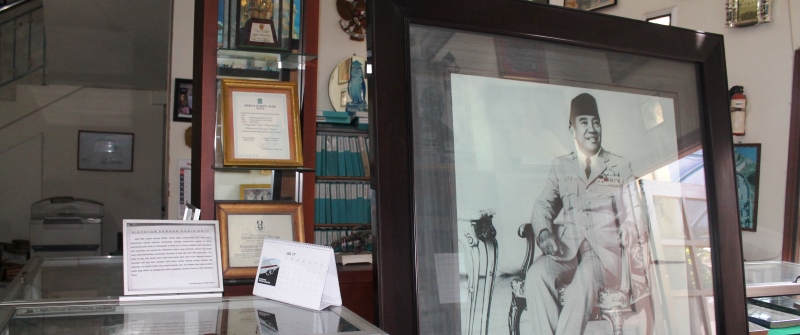
20 Jul Blog: Book-hunting in the City of Heroes
By Tom Hoogervorst
Situated in an inconspicuous residential area in the south of Surabaya, one could easily overlook one of Indonesia’s most intriguing libraries and its equally fascinating owner. Tom Hoogervorst looks back on a fruitful week of research spent at Medayu Agung.
“Some of the books are a bit sticky”, says Mr. Oei Hiem Hwie, as he deftly separates the pages of a 1919 book on traditional medicine. “I had to hide my collection above the ceiling of my old house. They burnt many of my possessions. In the end, everything was buried under a 15 cm coat of dust.”
Known to his friends as Pak Wie, the Malang-born septuagenarian and life-long book collector heads a unique library open to Indonesian and international visitors: Medayu Agung. Every day, students, journalists, intellectuals, and cultural activists can be spotted browsing through its books and newspapers. The library contains material in Indonesian, Chinese, Javanese, Dutch, English and German – among others – ranging from colonial to recent times. In addition to this wealth of printed sources, innumerable beautiful black-and-white photos of old Surabaya and other historical paraphernalia make it a living museum. Even an original edition of Mein Kampf signed by Adolf Hitler himself has found its way into the library.
The history of Medayu Agung is closely connected with the history of Indonesia. In 1965, at the peak of his journalistic career, Pak Wie was imprisoned without a trial on the unfounded suspicion of involvement with Indonesia’s communist party. As a result, he was detained for 13 years in some of the country’s most notorious prisons, including the gulag-style internment camps of Nusakembangan and Buru. While incarcerated, he developed a close friendship with fellow convict Pramoedya Ananta Toer, who later became Indonesia’s most famous writer. His ground-breaking “This Earth of Mankind” (Bumi Manusia) was first written down on pieces of paper smuggled in by Pak Wie. They are still kept in the library.
The intellectual spirit of Pramoedya runs deeply through the two-storey building. Several bookcases are dedicated to publications on him and by him. No less rich is the material on Sukarno, Indonesia’s first president whom Pak Wie regularly met while writing for the newspaper Trompet Masjarakat in the early 1960s.
As an unapologetic left-wing thinker in a country that continues to struggle with a gruesome episode from its past, it seemed impossible for Pak Wie to ever realize his big dream: building a library for Indonesia’s future generation whose purpose would be to combat the historical erasure perpetuated by their predecessors. Just when he was close to despair, an old friend who had become a successful entrepreneur decided to fund the Medayu Agung initiative. There was only one condition: Pak Wie had to move what remained of his collection from Malang to Surabaya, a city known for its rich history.
The results have been impressive. Medayu Agung is a welcoming, inclusive place. A diverse array of languages can be heard amidst its bookshelves. The staff crack jokes in rapid-fire East Javanese and earthy Madurese. An old friend drops by for a chat in the beautiful, antiquated Malay of the city’s elderly Chinese community, before bursting into a Mandarin song he learned back in his school days. Representatives of all major religions have sent tokens of their appreciation, placed fraternally on display in a big cabinet.
Indeed, the tables seem to have turned, along with Indonesia’s political climate. Yet despite the presence of an entire room filled with prizes and certificates awarded by the government, Medayu Agung remains a crowdfunded project. “Things have definitely become better,” Pak Wie concludes. “But it’s all relative. Many of the people who wanted me imprisoned and my books destroyed are still within the corridors of power.”
(Tom Hoogervorst focuses on language contact and Malay linguistics. He is currently studying the development of the (Indonesian) Malay language through the KITLV’s collection of Sino-Malay literature, while simultaneously attempting to cast a new light on cultural contact, the introduction of new concepts and the role of popular culture during late 19th and early 20th centuries.)




No Comments